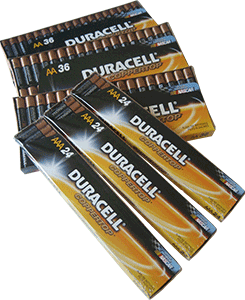The batteries in your avalanche transceiver will typically last 200 to 300 hours depending on the type of transceiver you own and how much searching you do. At a minimum, an avalanche transceiver with fresh batteries must be able to transmit for 200 hours at 10°C (50°F) and then receive a signal for at least one hour at -10°C (14°F).
Install new, high quality batteries at the beginning of each season. All of the batteries should be replaced at the same time using same brand. Never use consumer-purchased rechargeable batteries, mix new and used batteries, or use mixed brands of batteries. Lithium batteries must only be used if they are supported by your transceiver (learn more).
Replace the batteries when they get low based on the manufacturer's recommendations. When in doubt, replace them when they reach 50% of capacity. Batteries are inexpensive—don't be a cheapskate at your partner's expense!
You should always remove the batteries at the end of each season to prevent damage due to battery leakage (battery leakage will void most manufacturer's warranties). According to Mammut, you should return your transceiver to the manufacturer and have the terminal contacts replaced if you see any corrosion on the terminals. You can learn more about batteries and avalanche transceivers in this blog post.

Digital transceivers display the strength of the batteries on the screen. Here are a few manufacturer's statements regarding their battery indicators:
The transceiver comparison table displays the manufacturer's stated battery life. For example, if the table shows "250/15", it means that the manufacturer states that the transceiver can receive for at least 250 hours (presumably at 10°C) or receive for 15 hours (presumably at -10°C).
You should only use lithium batteries in transceivers that support them. To see if your transceiver supports lithium batteries, view the transceiver comparison, select All for the Display Detail, and look on the Battery Type(s) row. As of this writing, the Barryvox S, Pieps Powder/BD Recon, Pieps Pro/BD Guide, and Pulse (beginning with version 3.2) can accept either alkaline or lithium batteries.
Avalanche transceiver need to know whether alkaline or lithium batteries are installed so they can accurately display the remaining battery strength. This is does using either a setting (i.e., using menus or an app) or by responding to a prompt after you install new batteries.
The advantage of lithium batteries is they don't leak corrosive acid (a primary cause of transceiver failure) and they last much longer than alkaline batteries (30% to 50% longer, according to the manufacturers).
The Ortovox Diract transceivers are rechargeable. Although you should never use consumer-grade rechargeable batteries, using manufacturer supplied rechargeable batteries in an avalanche transceiver is debatable. On the one hand, it is good to have batteries that don't need to be disposed of each year. On the other hand, if you don't discover that your batteries are low until just before you leave your house or worse, when you arrive at the trailhead, you can't simply replace the batteries with spares.